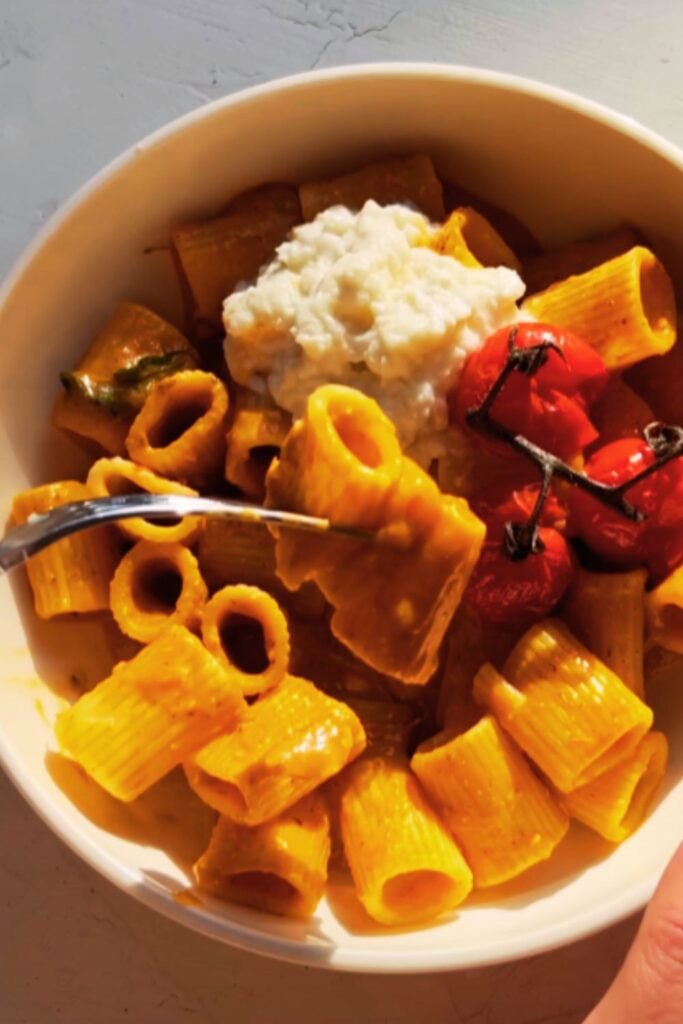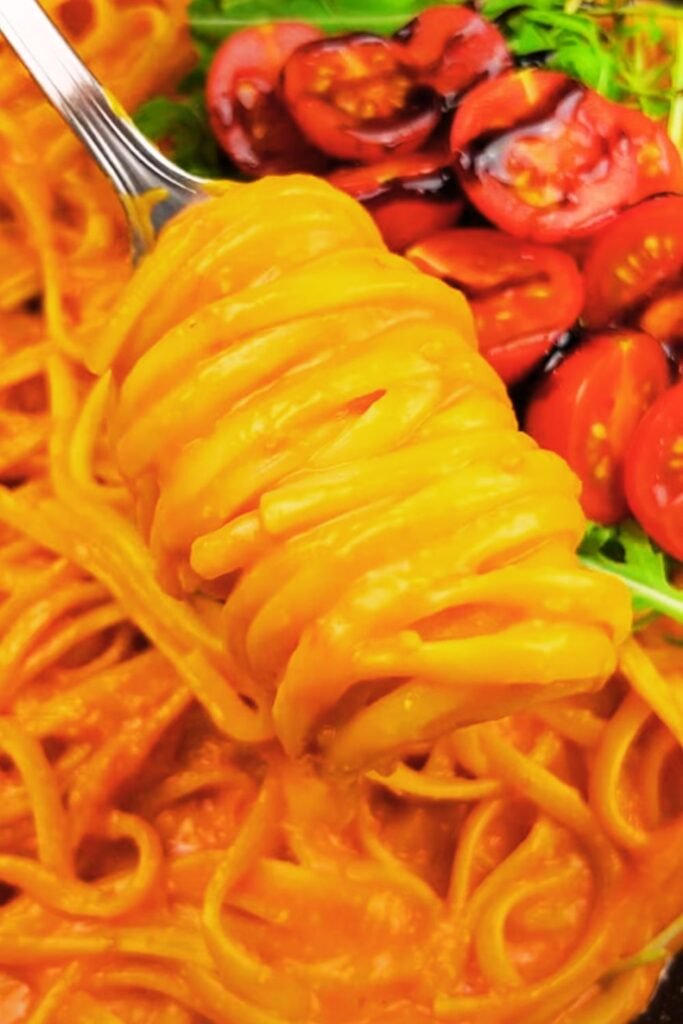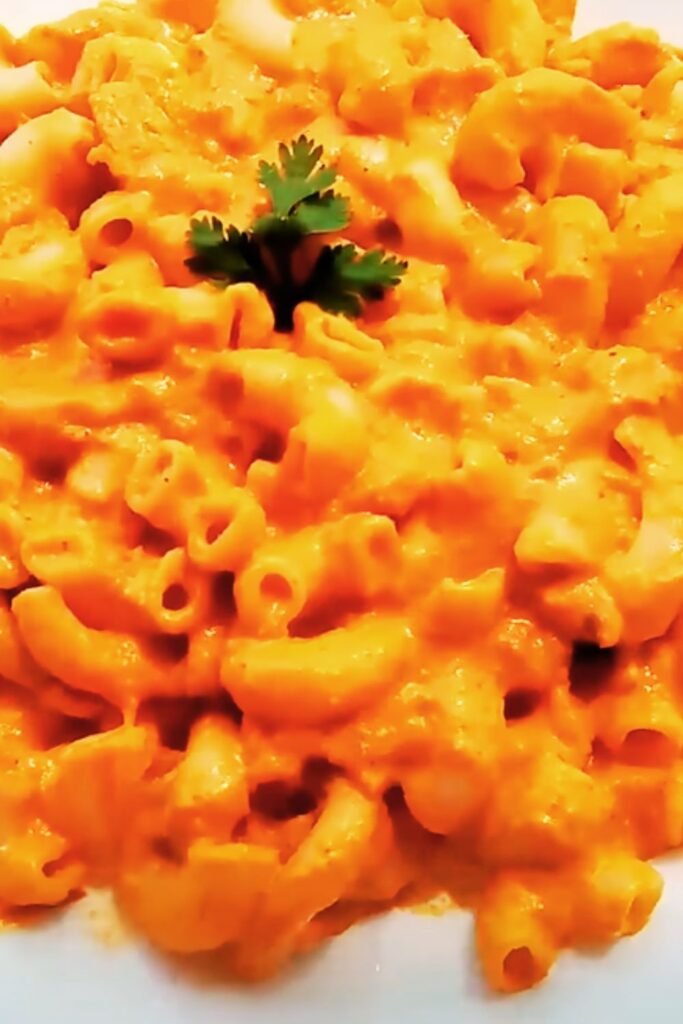There’s something magical about the combination of fresh tomatoes, aromatic garlic, and perfectly cooked pasta that never fails to make my heart sing. I’ve been making this creamy fresh tomato garlic pasta for years, and it remains one of my absolute favorite go-to recipes when I want something comforting, delicious, and surprisingly sophisticated without spending hours in the kitchen.
What started as a desperate attempt to use up an abundance of garden tomatoes has evolved into my signature dish that friends and family constantly request. The beauty of this recipe lies in its simplicity – using just a handful of quality ingredients to create something that tastes like it came from an upscale Italian restaurant.
Understanding Fresh Tomato Pasta
Fresh Tomato Pasta : A pasta dish that celebrates the natural sweetness and acidity of ripe tomatoes, typically prepared with minimal cooking to preserve the tomatoes’ fresh flavor and texture.
Garlic Confit : A cooking technique where garlic cloves are slowly cooked in oil at low temperature, resulting in tender, sweet, and mellow garlic flavor without any harshness.
Pasta Water : The starchy, salted water used to cook pasta, which serves as a natural emulsifier and helps bind sauces to pasta.
Emulsification : The process of combining oil and water-based ingredients to create a smooth, creamy sauce without using dairy products.
The magic of this dish comes from understanding how these elements work together. Unlike heavy cream-based sauces, this recipe achieves its creamy texture through proper emulsification techniques and the natural starches released from the pasta.
Why This Recipe Works So Well
I’ve tested countless variations of tomato pasta over the years, and this particular combination consistently delivers restaurant-quality results at home. The secret lies in treating the tomatoes gently – we’re not making a traditional marinara sauce here. Instead, we’re creating a fresh, vibrant sauce that lets the tomatoes shine while the garlic provides a aromatic foundation.
The cream element comes from a combination of techniques: using pasta cooking water as an emulsifier, incorporating a touch of butter for richness, and allowing the natural sugars in the tomatoes to concentrate slightly. This creates a luxurious mouthfeel without overwhelming the fresh flavors.
Essential Ingredients Breakdown
| Ingredient | Purpose | Selection Tips | Substitutions |
|---|---|---|---|
| Fresh Tomatoes (2 lbs) | Primary flavor base | Choose vine-ripened, slightly soft tomatoes | Cherry tomatoes, Roma tomatoes |
| Garlic (6-8 cloves) | Aromatic foundation | Look for firm, plump cloves | Garlic powder (1 tsp), shallots |
| Pasta (1 lb) | Texture and substance | Long pasta works best | Spaghetti, linguine, angel hair |
| Olive Oil (1/4 cup) | Cooking medium, richness | Extra virgin for best flavor | Avocado oil, vegetable oil |
| Butter (3 tbsp) | Creaminess, richness | Unsalted European-style | Vegan butter, additional olive oil |
| Fresh Basil (1/2 cup) | Brightness, aroma | Deep green, unblemished leaves | Dried basil (2 tsp), oregano |
| Parmesan (1/2 cup) | Umami, saltiness | Freshly grated Reggiano | Pecorino Romano, nutritional yeast |
| Heavy Cream (2 tbsp) | Luxurious finish | Optional for extra richness | Half-and-half, cashew cream |
Step-by-Step Preparation Method
Preparation Phase (10 minutes)
Before I start cooking, I always prepare all my ingredients. This French technique called “mise en place” makes the actual cooking process smooth and stress-free.
- Bring a large pot of salted water to boil for pasta
- Wash and core tomatoes, then cut into bite-sized chunks
- Mince garlic cloves finely (I prefer hand-mincing over pressing for better texture)
- Grate Parmesan cheese fresh (pre-grated doesn’t melt as smoothly)
- Pick basil leaves and set aside (don’t chop until ready to use)

Cooking the Pasta (8-12 minutes)
I cook my pasta until it’s just shy of al dente – about 1-2 minutes less than package directions suggest. This allows the pasta to finish cooking in the sauce, absorbing those beautiful flavors while maintaining the perfect texture.
Key pasta cooking tips:
- Use plenty of salted water (it should taste like seawater)
- Reserve 1 cup of pasta cooking water before draining
- Don’t rinse the pasta after draining
- Keep pasta slightly undercooked for sauce finishing
Creating the Garlic Oil Base (3-4 minutes)
In a large skillet over medium-low heat, I warm the olive oil and add the minced garlic. The key here is patience – we want the garlic to become fragrant and just barely golden, not brown or crispy. Burnt garlic will make the entire dish bitter.
I watch for these visual cues:
- Garlic starts to sizzle gently
- Aroma becomes nutty and sweet
- Color shifts to very light golden
- No harsh sizzling sounds
Building the Tomato Sauce (6-8 minutes)
Once the garlic is perfectly aromatic, I add the fresh tomatoes to the pan. The temperature contrast causes immediate sizzling, which is exactly what we want. This quick sear helps concentrate the tomato flavors while maintaining their fresh character.
I season generously with salt and freshly cracked black pepper, then let the tomatoes cook just until they start breaking down and releasing their juices. Some pieces should remain chunky for texture.
Combining and Finishing (3-5 minutes)
This is where the magic happens. I add the slightly undercooked pasta directly to the tomato mixture along with about 1/2 cup of the reserved pasta water. The starchy water helps create an emulsion with the olive oil, resulting in a silky sauce that clings to each strand of pasta.

I toss everything together vigorously, adding more pasta water as needed to achieve the perfect consistency. The sauce should coat the pasta but not be dry or too wet.
Finally, I remove the pan from heat and stir in the butter, fresh basil, and half of the Parmesan cheese. The residual heat will melt everything together into a glossy, restaurant-quality finish.
Nutritional Information and Benefits
| Nutrient | Per Serving | Daily Value % | Health Benefits |
|---|---|---|---|
| Calories | 485 | 24% | Moderate energy density |
| Protein | 18g | 36% | Complete amino acid profile |
| Carbohydrates | 72g | 24% | Sustained energy release |
| Fiber | 4g | 16% | Digestive health support |
| Vitamin C | 28mg | 31% | Immune system boost |
| Lycopene | 12mg | N/A | Antioxidant protection |
| Folate | 85mcg | 21% | Cellular health support |
| Iron | 3.2mg | 18% | Oxygen transport support |
Fresh tomatoes are nutritional powerhouses, packed with lycopene, vitamin C, and potassium. The garlic provides allicin, known for its antimicrobial and heart-healthy properties. When combined with whole grain pasta options, this becomes a well-balanced meal that supports both immediate satisfaction and long-term health.
Serving Suggestions and Pairings
I love serving this pasta as the star of a simple but elegant dinner. Here are my favorite accompaniments:
Protein additions:
- Grilled chicken breast, sliced thin
- Pan-seared shrimp with lemon
- Italian sausage, casings removed and crumbled
- Fresh mozzarella balls, torn
- Cannellini beans for vegetarian protein
Vegetable enhancements:
- Roasted zucchini and yellow squash
- Sautéed spinach or arugula
- Roasted red peppers
- Fresh corn kernels (summer variation)
- Sun-dried tomatoes for intensity
Bread pairings:
- Crusty Italian bread with olive oil dip
- Garlic bread (but keep it light to not compete)
- Focaccia with rosemary
- Simple bruschetta
Salad companions:
- Mixed greens with balsamic vinaigrette
- Caesar salad with light dressing
- Caprese salad with fresh mozzarella
- Arugula salad with lemon dressing

Recipe Variations and Adaptations
Seasonal Variations
Summer Version: When tomatoes are at their peak, I sometimes use a mix of heirloom varieties for complex flavor. Cherry tomatoes work beautifully too, especially when halved to release their sweet juices.
Winter Adaptation: During colder months, I’ll use high-quality canned San Marzano tomatoes, crushing them by hand for a more rustic texture.
Dietary Modifications
Vegan Version:
- Replace butter with additional olive oil or vegan butter
- Substitute Parmesan with nutritional yeast or vegan cheese
- Use plant-based cream alternative if desired
Gluten-Free Option:
- Use gluten-free pasta (rice-based or chickpea work well)
- Ensure all other ingredients are certified gluten-free
Low-Carb Alternative:
- Replace pasta with spiralized zucchini noodles
- Serve over spaghetti squash
- Use shirataki noodles for ultra-low carb
Troubleshooting Common Issues
Sauce Too Watery
If my sauce turns out too thin, I simmer it uncovered for a few extra minutes to reduce the liquid. Sometimes I’ll add a tablespoon of tomato paste to help thicken and intensify the flavor.
Pasta Overcooked
Prevention is key here – always cook pasta 1-2 minutes less than package directions when you plan to finish it in the sauce.
Garlic Burnt
If the garlic gets too dark, I start over. Burnt garlic will make the entire dish bitter, and there’s no recovering from that mistake.
Sauce Won’t Emulsify
This usually happens when the pan is too hot or there’s not enough pasta water. I add more starchy pasta water and toss vigorously off the heat.
Storage and Reheating Guidelines
| Storage Method | Duration | Quality | Reheating Instructions |
|---|---|---|---|
| Refrigerator | 3-4 days | Good | Add splash of water, reheat gently |
| Freezer | 2-3 months | Fair | Thaw overnight, reheat with cream |
| Room Temperature | 2 hours max | Good | Consume within safe time limits |
I prefer to store the sauce and pasta separately when possible, as this maintains better texture when reheating. The sauce actually improves in flavor after a day in the refrigerator as the flavors meld together.
When reheating, I add a splash of water or broth to loosen the sauce and heat everything gently to avoid breaking the emulsion.
Professional Tips and Techniques
Through years of making this dish, I’ve discovered several techniques that elevate it from good to exceptional:
Temperature Control: Keep the heat at medium-low throughout most of the cooking process. High heat can cause the garlic to burn and the tomatoes to become mushy rather than maintaining their fresh character.
Pasta Water Magic: The starchy pasta cooking water is crucial for creating the creamy texture. I always save at least a cup, even if I don’t think I’ll need it all.
Fresh Basil Timing: Add basil at the very end and only tear it by hand. Cutting basil with a knife can cause it to bruise and turn black.
Cheese Integration: Remove the pan from heat before adding Parmesan to prevent it from becoming stringy or clumpy.
Questions and Answers
Q: Can I make this recipe ahead of time for meal prep?
I don’t recommend making the complete dish ahead, as pasta tends to absorb the sauce and become mushy. Instead, I prepare the tomato-garlic sauce base and store it separately. When ready to eat, I cook fresh pasta and combine them, which takes only about 10 minutes total.
Q: What’s the best type of tomato to use for this recipe?
My preference is vine-ripened tomatoes that give slightly when pressed but aren’t mushy. Roma tomatoes work well for a meatier texture, while beefsteak tomatoes provide more juice. Cherry tomatoes create a sweeter, more concentrated flavor when halved.
Q: How can I make this dish more protein-rich without changing the flavor profile?
The easiest addition is to toss in some white beans (cannellini or navy beans work great) during the last few minutes of cooking. They absorb the sauce flavors beautifully and add substantial protein without competing with the tomato-garlic base.
Q: My sauce always turns out too acidic. How can I balance this?
Tomato acidity varies greatly depending on variety and ripeness. I balance acidic tomatoes by adding a pinch of sugar or a small splash of balsamic vinegar, which might sound counterintuitive but actually helps round out the flavors. The butter and Parmesan also help neutralize acidity.
Q: Can I use dried herbs instead of fresh basil?
Fresh basil really makes a difference in this recipe, but if you must use dried, add it earlier in the cooking process (with the tomatoes) and use about 1 tablespoon instead of the fresh amount. The flavor won’t be quite the same, but it’s still delicious.
Q: What’s the secret to getting restaurant-quality results at home?
The biggest difference is patience and proper technique. Don’t rush the garlic cooking, use plenty of pasta water for emulsification, and finish the dish off the heat with butter and cheese. Also, taste and adjust seasoning at every step.
Q: How do I prevent the cream from curdling when I add it?
The key is to add cream off the heat and in small amounts. I actually prefer using just butter and pasta water for creaminess, but if you want to add cream, make sure the pan isn’t too hot and stir it in gently at the very end.
Q: Can I double this recipe for a large group?
Absolutely! This recipe scales up beautifully. Use a very large skillet or even divide between two pans to ensure even cooking. You might need to adjust cooking times slightly for larger quantities of tomatoes.
This creamy fresh tomato garlic pasta represents everything I love about Italian-inspired cooking: simple ingredients treated with respect, proper technique, and the patience to let flavors develop naturally. Every time I make this dish, I’m reminded why sometimes the most straightforward recipes are the most satisfying. The combination of sweet tomatoes, mellow garlic, and perfectly cooked pasta creates a meal that feels both comforting and sophisticated – exactly what I want on my dinner table.